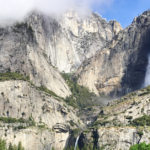When you think of national parks, what are your favorite ways to enjoy them? Do you challenge yourself with adventurous hikes through canyons or across snow-covered mountains? Do you like to drive to viewpoints to take in the vast desert or ocean views?
While there are thousands of travelers every day visiting these parks leaving nothing behind but footprints and leaving with nothing but memories, there are thousands of others treating them like a cheaper alternative to Six Flags or Disneyland.
National parks have become less of a place of relaxation and exploration and more of an Instagram destination to be ruined by rogue hikers and drone pilots.
The original intention for these parks was for them to be for conservation — a place where anyone could visit and appreciate nature as long as they respected it. Our perceptions of national parks have changed since their creation, and not for the better. So how have our attitudes towards our national parks changed since their inception and what can we do to improve our present-day behavior?

Protected Spaces for Conservation
The concept of conservation wasn’t always in the American public consciousness. Much of the continent of North America wasn’t even accurately mapped by the time of the foundation of the United States, so its wilderness seemed so vast that even the Founders like Thomas Jefferson thought that it would take the better part of a millennium for Americans to settle (Ken Burn’s “The West”).
To them, the entire continent was essentially a national park (Ken Burn’s “The National Parks”). The very idea that humanity could alter or affect nature was unfathomable to the public consciousness at the time, for it had never observed it. However in true American fashion, settlers advanced westward and laid claims along the West Coast by the 1850s — so much for taking a millennium.
As more Americans settled throughout the continent, their presence changed the natural landscape and its ecosystems — so much so that entire species like the buffalo neared extinction, and remarkable natural formations in sites like Yosemite Valley and Yellowstone were threatened by decimation.
Realizing that these unique sites could become lost forever, early naturalists and environmentalists rallied and politically originated to preserve these endangered areas, leading to the creation of the world’s first national park, Yellowstone, in 1872, and then the Yosemite National Park in 1890. To these environmentalists, like Theodore Roosevelt and John Muir, these environments were just as sacred as any place of worship, that “a grove of giant redwood or sequoias should be kept just as we keep a great and beautiful cathedral.”
Their objective, and what ultimately became the mission of the National Park Service (NPS) at its founding in 1916, was to provide visitors with environments for their use and enjoyment, but “in such a manner and by such a means as will leave them unimpaired” for future generations. It would only take about thirty years before the American public would change its interpretation of conservation.

Amusement Parks Without the Coasters
The end of World War II saw a great change in American society. Soldiers were returning from abroad and starting families, thus creating unprecedented growth of the middle class. At the same time, automobile culture was booming. It was difficult to find a single household without at least one car.
American households also now had more disposable income than previous generations ever did, and their appetites for entertainment and their newfound accessibility to the open road gave birth to the idea of the great American road trip, and the national parks were marked on everyone’s maps. To accommodate the rise in visitors, the NPS began to build more infrastructure, like roads, high-end lodgings, restaurants, and shops, to accommodate visitors and their comforts.
By then, the public perception of parks changed. They were no longer considered cathedrals and temples to the natural world, but rather amusement parks. Sure, conservation efforts and research have continued through to the present, yet these are constantly ruined as visitors by the millions trespass into wildlife conservation sites every year, which has exacerbated the mindset that these places are merely backdrops for our social feeds and obstacle courses for our noisy drones.
At the same time, most funding for these efforts have been cancelled by the current administration as it has prioritized resource extraction and selling public land to private developers. Today, the original mission of the NPS and its founders is as threatened as the many species it’s trying to protect.

How to Preserve and Enjoy National Parks
If public perception about them changed once, then we can change them again, and for the better this time. Here’s how you can enjoy each park while preserving them for posterity.
Always remember that these places are as precious as any place of worship. There are sites of beauty that are unique to our planet that are still teaching us so much about life. If you wouldn’t behave in a place of worship that way, don’t behave like that near Bridalveil Falls in Yosemite National Park. Stay quiet, leave space for others, and be respectful of your surroundings.
Be respectful while visiting. Keep to the trails and the rules. Don’t disregard either or trespass to get that perfect shot. These areas are not blocked off to challenge you. Instead, they are blocked off to restore and protect the life that’s there and to potentially save your life. Avoid getting close to wildlife as to not scare them away and avoid potential wildlife attacks. And finally, don’t leave with anything from the trails. Leave those shells, sticks, and stones where they belong and don’t add to this collection of items by leaving behind your energy bar wrappers.
Keep the noise down. You may be on top of the world and enjoying a beautiful, natural high from a wonderful, life-changing hike. But you’re still in other animals’ natural habitats. Noise pollution can scare other animals so much that they may accidentally abandon their young before they have learned to survive on their own. As for humans, we don’t want to hear your speakers blaring at the top of the viewpoint. Please put on your headphones if you’d prefer to listen to Spotify than the wildlife and bodies of water around you.
Create a safe space for all who want to visit. Many racist groups and institutions discourage BIPOC from visiting, enjoying, and learning about these places. The fundamental mission of the NPS is to welcome all respectful visitors, even though white supremacists think these spaces are solely for white Americans. Additionally, creating a “safe space” now goes beyond race and is now a matter of public health. If you choose to visit a busy park, leave enough space for others. It’s not just polite, but also now a matter of public health safety.
Support legislation that will fund and defend the maintenance of the parks’ infrastructure as well as scientific research and wildlife conservation. Sign petitions, attend public forums, share news on our social platforms. Use your voice to bring attention to the issues that are hurting the parks rather than exacerbating them.

The expansion of the American way of life across the continent and beyond may have yielded a higher standard of living for its people, yet it has done so at the expense of the natural wonders and indigenous peoples who were flourishing here millennia before the founding of the U.S. The advent of environmentalism and the creation of the National Park Service was a solution to that great issue at a time when the threat of losing the natural world seemed quite likely. It succeeded, yet we fell back to our destructive patterns in less than a century.
If we as a society look upon these spaces as temples to the wonders of our planet rather than merely backgrounds to our social media feeds, then we and our descendants will enjoy and learn from them for years to come. These natural wonders of the world do not have to be gone with the flash of your camera.
To never miss one of our articles, sign up for our newsletter via the form on the right side of the page.














One Response
Love Yosemite, it is one of the most beautiful places in CA!